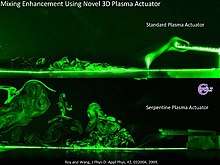Serpentine geometry plasma actuator
The serpentine plasma actuator represents a broad class of plasma actuator. The actuators vary from the standard type in that their electrode geometry has been modified in to be periodic across its span.[1][2]

History
This class of plasma actuators was developed at the Applied Physics Research Group (APRG) at the University of Florida in 2008 by Subrata Roy for the purpose of controlling laminar and turbulent boundary layer flows. Since then, APRG has continued to characterize and develop uses for this class of plasma actuators. Several patents resulted from the early work on serpentine geometry plasma actuators [3][4][5][6][7]
In 2013, these actuators started to get broader attention in the scientific press, and several articles were written about these actuators, including articles in AIP's EurekAlert,[8] Inside Science [9] and various blogs.[10][11]
Current Research and Operating Mechanisms
_and_serpentine_geometry_palsma_actuators..png)
Serpentine plasma actuators (like other Dielectric Barrier Discharge actuators, i.e. plasma actuators) are able to induce an atmospheric plasma and introduce an electrohydrodynamic body force to a fluid. This body force can be used to implement flow control, and there are a range of potential applications, including drag reduction for aircraft and flow stabilization in combustion chambers.[12]

The important distinction between serpentine plasma actuators and more tradition geometries is that the geometry of the electrodes has been modified in order to periodic across its span. As the electrode has been made periodic, the resulting plasma and body force are also spanwise periodic. With this spanwise periodicity, three-dimensional flow effects can be induced in the flow, which cannot be done with more traditional plasma actuator geometries.
It is thought that the introduction of three-dimensional flow effects allow for the plasma actuators to apply much greater levels of control authority as they allow for the plasma actuators to project onto a greater range of physical mechanisms (such as boundary layer streaks[13] or secondary instabilities of the Tollmien-Schlichting wave). Recent work indicate that these plasma actuators may have a significant impact on controlling laminar and transitional flows on a flat plate.[14][15] In addition, the serpentine actuator has been experimentally demonstrated to increase lift, decrease drag and generate controlling rolling moments when applied to aircraft wing geometries. [16]
With the greater level of control authority that these plasma actuators may potentially possess, there is currently research being performed at several labs in the United States[17][18] and in the United Kingdom[19] looking to apply these actuators for real world applications.
See also
- Plasma actuator
- Wingless Electromagnetic Air Vehicle
- Applied Physics Research Group
- University of Florida
- University of Florida College of Engineering
References
- Roy, Subrata, and Chin-Cheng Wang. "Bulk flow modification with horseshoe and serpentine plasma actuators." Journal of Physics D: Applied Physics 42.3 (2009): 032004.
- Riherd, Mark, and Subrata Roy. "Serpentine geometry plasma actuators for flow control." Journal of Applied Physics 114.8 (2013): 083303.
- United States Patent No. 8,382,029 Issued on February 26, 2013.
- Hong Kong Patent No. 1129642B Issued on June 29, 2012.
- Chinese Patent ZL200780036093.1 Issued on October 19, 2011.
- European Patent EP 2,046,640 Issued on October 12, 2011.
- Japanese Patent no. 5,220,742 granted on March 15, 2013.
- "Wrangling flow to quiet cars and aircraft," EurekAlert, http://www.eurekalert.org/pub_releases/2013-10/aiop-wft101813.php, viewed on 1/20/2014.
- "Snakelike Zaps To Flowing Air Could Improve Vehicle Aerodynamics," Inside Science News Service, http://www.insidescience.org/content/snakelike-zaps-flowing-air-can-improve-vehicle-aerodynamics/1477, viewed on 1/20/14.
- "New plasma actuator geometry may help boost aerodynamic performance," Design, Products, and Applications, http://www.dpaonthenet.net/article/63584/New-plasma-actuator-geometry-may-help-boost-aerodynamic-performance.aspx, viewed on 1/20/2014.
- "Less Turbulence: Plasma Actuators Could Mean Quieter Cars and Aircraft" Scientific Blogging 2.0, http://www.science20.com/news_articles/less_turbulence_plasma_actuators_could_mean_quieter_cars_and_aircraft-122635, viewed on 1/20/2014.
- Wang, Chin-Cheng, and Subrata Roy. "Combustion stabilization using serpentine plasma actuators." Applied Physics Letters 99.4 (2011): 041502-041502.
- Butler, Kathryn M., and Brian F. Farrell. "Three‐dimensional optimal perturbations in viscous shear flow." Physics of Fluids A: Fluid Dynamics 4 (1992): 1637.
- Riherd, Mark, and Subrata Roy. "Serpentine geometry plasma actuators for flow control." Journal of Applied Physics 114.8 (2013): 083303.
- Dasgupta, Arnob, and Subrata Roy. "Three-dimensional plasma actuation for faster transition to turbulence." Journal of Physics D: Applied Physics 50.42 (2017): 425201.
- Iranshahi, Kamran, and Mani, Mahmoud. "Dielectric Barrier Discharge Actuators Employed as Alternative to Conventional High-Lift Devices." Journal of Aircraft (2018): https://doi.org/10.2514/1.C034690.
- Rizzetta, Donald P., and Miguel R. Visbal. "Numerical investigation of plasma-based control for low-Reynolds-number airfoil flows." AIAA journal 49.2 (2011): 411-425.
- Rizzetta, Donald P., and Miguel R. Visbal. "Effect of Plasma-Based Control on Low-Reynolds-Number Flapping Airfoil Performance." AIAA journal 50.1 (2012): 131-147. APA
- Wang, Jin-Jun, et al. "Recent developments in DBD plasma flow control." Progress in Aerospace Sciences 62 (2013): 52-78.